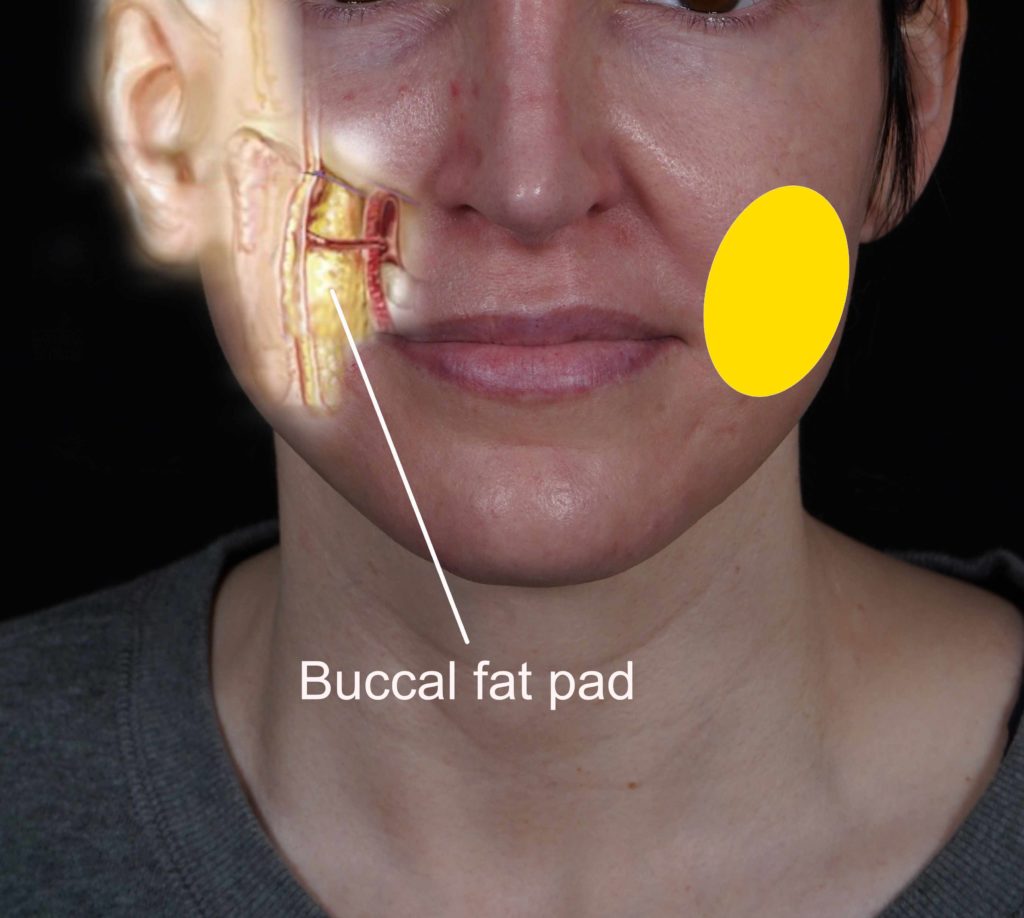 One of the most effective procedures to thin out someone’s face is called buccal fat removal, or buccal fat reduction. The buccal fat references a pad of concentrated fat that is located in the middle of the cheek just to the side of the corner of the mouth. This is shown in the adjacent photo diagram that highlights the area of the cheek that is shaped and formed by the buccal fat pad. Anatomically, the buccal fat pad is located between the thin, cheek muscle (called the buccinator muscle) that runs along the inside of the mouth and the skin that covers the face. The fat is actually contained within a pocket or space and is surrounded by a number of key blood vessels and nerves. In most patients, the buccal fat pad is approximately the size of a golf ball. Other than providing you some degree of cushioning, there is no real purpose to the buccal fat pad. Therefore, buccal fat pad removal, or buccal fat reduction, typically does not have any negative consequences in terms of function.
One of the most effective procedures to thin out someone’s face is called buccal fat removal, or buccal fat reduction. The buccal fat references a pad of concentrated fat that is located in the middle of the cheek just to the side of the corner of the mouth. This is shown in the adjacent photo diagram that highlights the area of the cheek that is shaped and formed by the buccal fat pad. Anatomically, the buccal fat pad is located between the thin, cheek muscle (called the buccinator muscle) that runs along the inside of the mouth and the skin that covers the face. The fat is actually contained within a pocket or space and is surrounded by a number of key blood vessels and nerves. In most patients, the buccal fat pad is approximately the size of a golf ball. Other than providing you some degree of cushioning, there is no real purpose to the buccal fat pad. Therefore, buccal fat pad removal, or buccal fat reduction, typically does not have any negative consequences in terms of function.
Buccal Fat Excess
When the buccal fat pad is too large or the amount of fat in the cheek is excessive, patients will note a more rounded, or full, face. Some refer to buccal fat excess as giving them a face that appears too chubby. Others call them chipmunk cheeks for obvious reasons. Now we often times say that ‘volume is a sign of youth’ in the world of facial plastic surgery. However, when there is simply too much buccal fat, the face can look much too rounded, which will detract from having a more defined look. In many male patients seeking buccal fat pad surgery, the goal is to create a more ‘chiseled’ look. Many female patients seeking buccal fat removal state they desire a slimmer facial appearance. Regardless of sex, buccal fat removal can provide for a more angled face and cheek contour.
Buccal Fat Removal
In cases where there is simply too much buccal fat, removal or reduction of the fat pad can be very rewarding to patients. In doing so, the face becomes less rounded and more defined because new shadows are then created along the mid portion of the cheek. Instead of light reflecting off of the fuller, more convex cheek surface, it shadows in the area where the buccal fat was reduced. Consequently, the buccal fat removal can contribute to a more sculpted looking face in most patients.
In many cases, the buccal fat pad can be removed under local anesthesia injected into the cheek to numb the area. In cases where patients are a bit more anxious, light sedation can be used to accomplish the buccal fat pad reduction.
In order to remove the excess buccal fat, it is approached by going through the inside of the mouth. As noted earlier, there are a number of key anatomical structures that need to be preserved, which course through and around the buccal fat pad. So it is important to go to a board certified facial plastic surgeon who understands the anatomy of the cheek. A carefully placed, relatively short incision is made inside of the mouth. This is then used to access the buccal fat pad, which sits deep inside of the cheek. The excess fat is gently teased out and removed. Usually an absorbable suture is placed that does not have to be removed. The space that was previously occupied by the buccal fat, which was removed, will scar inward over a period of several weeks to months.
Buccal fat pad removal typically takes about 15-30 minutes to complete. The patient is recommended to ice the cheeks for upwards of 3-4 days after the surgery. Many patients will notice some degree of swelling and possibly some bruising of the cheek, but this is usually not very significant. It is recommended that patients avoid vigorous activity for at least seven days after buccal fat pad reduction.
Dr. John Hilinski has either authored or reviewed and approved this content.


